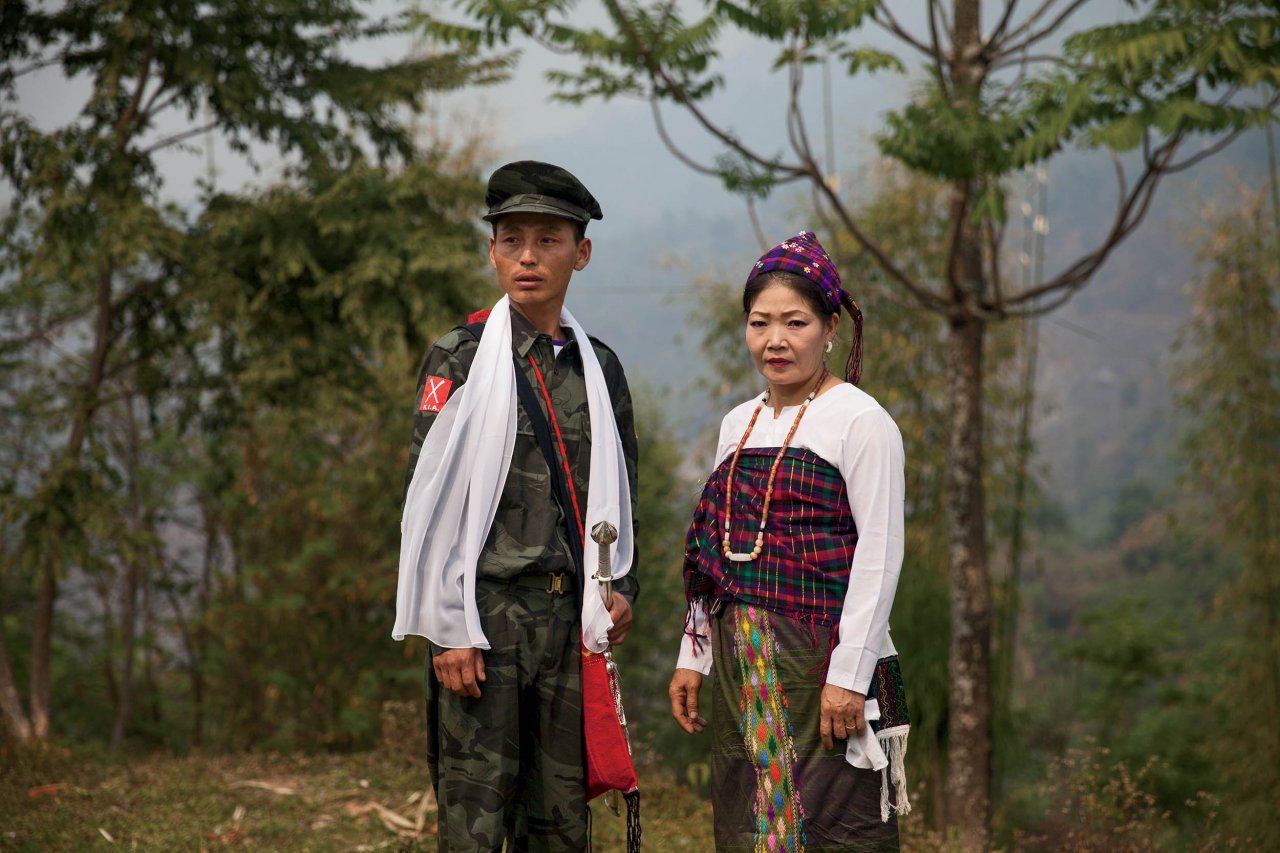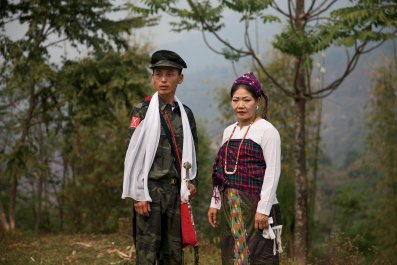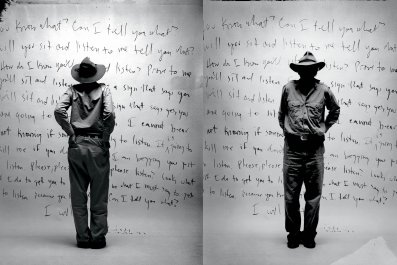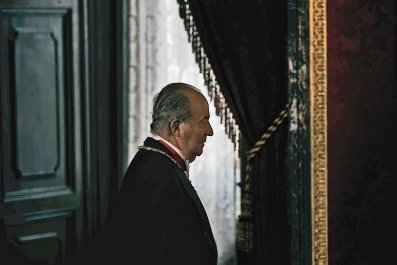Outside a makeshift church high in the mountains of Kachin State, northern Burma, 30 brides fuss with their dresses, fix each other's makeup and wait for the opening bars of Richard Wagner's Wedding March. Their grooms stand apart in the bright sunlight, sweating in the dark green uniforms of the Kachin Independence Army (KIA), one of the country's largest ethnic rebel groups. They smoke and toe the dirt with their polished boots, trying to seem oblivious to the scores of well-wishers waiting for them inside.
Today's event, a mass wedding organised by the KIA and paid for by local businesses, may be these couples' only chance to get married. And they are the lucky ones.
"When I heard about the wedding, I knew we had to do it," says one of the grooms, Private Mahaw Gam Hpang. "My girlfriend and I have been in love for a very long time, but we could never dream of being man and wife."
Three years into a war with the Burmese government that has killed several thousand civilians and displaced more than 100,000 more, the Kachin – devout Christians in Buddhist Burma – are a people under siege. With most able--bodied men fighting to defend the patchwork rebel territory or migrating in search of work, and few earning more than $100 a month, wedding ceremonies are considered an impossible luxury.
Hpang, 22, and his bride-to-be, Wahpai Shing Htang, 23, are childhood sweethearts. After the Burmese army attacked their village three years ago, Htang fled with her parents to one of the internally displaced persons (IDP) camps along the Burma-China border. Hpang joined the KIA. But as a low-ranking soldier whose family had been displaced by the fighting, the cost of a traditional marriage far exceeded his means.
Weddings in Kachin culture are a big deal. The vows are an affirmation of their Christian identity, which sets them apart from other Burmese. Multiple clans and whole communities are involved in the ceremonies, which are also expensive and hard to organise. A typical wedding costs $3,000 to $4,000. On top of that the groom must present the bride's family with a series of traditional gifts – ranging from a buffalo to silk blankets and gold jewellery, and worth on average about $2,500 – before they will bless the union.
"In these troubled times, we wanted to do something good for our soldiers," says Lieutenant Colonel Share Zau Doi. As commander of KIA security forces in the central region, he is an unlikely wedding planner. But he's clearly enjoying the day, warmly greeting the guests and holding court with the media. For all his sentimental bluster – he talks expansively about the beauty of holy matrimony and the pride he takes in playing a small part in the couples' happiness – his reasons for organising this all-expenses-paid spectacle are strictly military.
"Emotionally, they need the support of wives and children. A good Christian household. When morale is good, they are better fighters," he says.
The ceremony begins and the young couple, looking a little nervous, joins the procession into the church. Htang enters first, walking solemnly in step with the other brides past the 250 or so guests seated in rows of pastel-coloured plastic chairs. Hpang follows with the grooms and the 30 couples take their place to the right of the stage, where the pulpit and a bright arrangement of roses, carnations and lilies have been set up.
One of the pastors – five from the Baptist church are on hand, along with a Catholic priest – offers opening remarks. He wears a white tunic and ceremonial Kachin headscarf, and in his sermon talks at length about the Israelites. Their example is popular with religious leaders here, for obvious reasons: like the 12 tribes of the Old Testament, the Kachin are a small, embattled minority chosen, according to local belief, by God to keep the faith in this forgotten corner of the world.
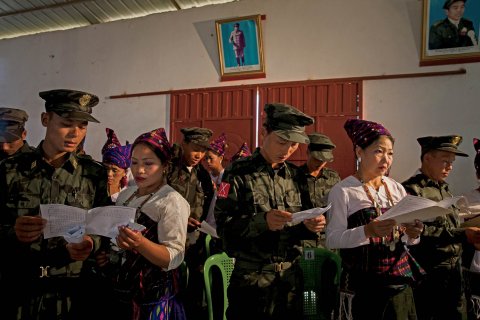
It's hard to tell if any of the brides or grooms are actually listening. Hpang and Htang aren't the only ones who look suddenly scared, more stunned than happy as they face the flashing cameras and the friendly stares.
But there's another reason for the couple to feel nervous: their secret, that they have been living together for the past several years, is now public. Many of the other couples here today have been doing the same. Some even had children out of wedlock.
"In our Kachin society, living together without marriage is a sin. The church cannot accept this. But marriage is difficult. So it is very common nowadays, during the war, for couples to form some kind of secret relationship," says the Reverend Chinle Zau Awng, one of the Baptist pastors. Still, he was surprised to see three couples from his own congregation.
"They did not dare face me beforehand because they were ashamed. But when they are married, it will be OK. They can attend church with their heads held high," he says.
The subtext of the mass wedding is that it provides a form of spiritual amnesty for everyone involved. Ceremonies like this, a recent phenomenon, are a good way of addressing the growing issue of extramarital relations among the Kachin.
There are more sermons, a musical interlude, and a speech from the commander. About two hours into the ceremony, the taking of the vows finally begins.
The Catholics go first, the lone priest marrying each of the three couples in turn. Then it's the Baptists' turn, with all 27 pairs, forming a semicircle at the front of the hall and exchanging vows. The marriage ceremony involves a few traditional flourishes. After a woman soldier hands out the wedding rings on a velvet cushion, the brides receive ceremonial Kachin swords to sling around the grooms' necks, a symbol of strength and kinship between their families.
Not all the couples are young like Hpang and Htang, and not all of them have been "living in sin". There are war widows in their 40s and 50s who are marrying much younger soldiers, in some cases their dead husbands' comrades.
Today the majority of Kachin, more than 90%, are Christian and the KIA, while officially secular, embraces Christian values. "Without Christianity, the Kachin culture would be extinct," says Awng. The Kachin believe that prior to the arrival of Christianity in Burma in the 19th century, they were a wild and profligate people, weakened by infighting and a fondness for opium. They believe European missionaries were sent by God to lead them out of the spiritual wilderness.
But Christianity also helped preserve Kachin culture for a more practical reason: the missionaries were the first to give the Kachin language a written script, romanising it to create the first Kachin-language Bible. Since then, most social, intellectual and political activity has revolved around the church.
According to Mandy Sadan, a lecturer in southeast Asian history at the University of London's School of Oriental and African Studies, the Kachin's "distinctive religious beliefs and the experience of religious discrimination", coupled with interethnic violence, helped galvanise their resistance to the Burmese government – a movement which began more than 50 years ago.
Captain Nlum Brang still remembers being chased off his parents' land by Burmese soldiers in 1965. "I joined the KIA as soon as I was old enough. It was my duty to fight this injustice," he says. Two generations later, the conflict continues.
As the ceremony wraps up and the newly married couples spill out into the sunshine, Hpang and Htang sit together and talk about their future as husband and wife. "It feels good," says Htang. "No more secrets."
They speak confidently of a time when peace is restored, when they plan to return home to their village and resume farming.
For now, though, their plans are on hold. There has been fresh fighting between the KIA and the Burmese army.
Tomorrow, the young husband will return to his military post, and his new wife will be left with her parents in the IDP camp.



